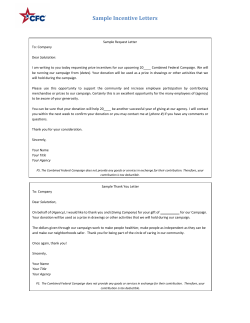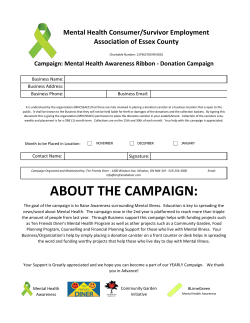
Avoiding Narrow Think (1)
Multi Cultural Strategy Sheet Avoiding Narrow Think PART OF A STRATEGY SHEET SERIES FROM DSGMEDIA WHEN CONSIDERING if a communications idea is good or bad, people think of themselves as the target audience, and that’s a big mistake. In fact, in most states and political jurisdictions, there are several voting audiences. And, the people running the campaign are not normal. Why? They think about politics more than 24 hours a day! Most “real people” think about politics just a few minutes each day, if at all. So, let’s say the campaign team is thinking about a major policy announcement, and one person says, “Hey, let’s annex the city of Oompaloompaville!” Then, someone says, “Oompaloompaville? Why would we do that? It’s full of Oompalavooians!” And no one challenges him, or points out that he may be expressing a personal bias, as opposed to a professional, fact-based opinion. This way of thinking is called Narrow Think, and it’s dangerous. When strategy, message, and tactics are created, campaigns must engage in an unnatural act: They must stop using Narrow Think (thinking as themselves) and start using Multi-Cultural Think: Thinking like an audience that looks like the political jurisdiction the candidate or cause wants to connect with (i.e., your target audience). Personal Check WRONG Narrow Think RIGHT Multi-Cultural Think Only when a campaign truly respects and understands the audience is it possible to come up with winning strategies, tactics, and language which will effectively communicate with that audience. When a campaign bases its communications efforts on in-house assumptions, unresearched opinions, and subtly biased attitudes, failure is inevitable*. Although this seems like common sense, Multi-Cultural Think it is often overlooked. We believe that it should be an integral part of your campaign, *Do you (or does your from beginning to end. campaign) secretly wear this button? If so, take it Winning campaigns reflect the off, right now. constituents they aspire to represent. They adopt Multi-Cultural Think by building a campaign team that mirrors the district. In the example above, there would be Oompalavooians in the room, with experience and expertise in communicating effectively with other Oompaloompavians for this discussion, as well as all other potential constituencies in the District who would be affected by an annex. Narrow Think vs. Multi-Cultural Think Let’s annex Oompaloompaville! Idea Let’s annex Oompaloompaville! Idea I don’t like Oompaloompaville, so we shouldn’t annex it. Reaction (Narrow Think) Will it resonate with the target audience? Reaction (Multi-Narrow Think) Oompaloompaville Hey, what about us?? Target Audience Oompaloompaville Hey, it might! Target Audience TIP When stuck in Narrow Think mode, listen to and respect the ideas and opinions of those around you who more closely match your target audience. Sure, various segments of the electorate may be at odds, but that’s real life — and if you can work out differences within the confines of a conference room, chances are you can present a solution that gets you closer to 50% plus 1 of the vote. Remember this fact: The more unlike your target audience you are, the harder it will be for you to adopt Multi-Cultural Think, and the more critical the need to have the input of those who more closely think like your target audience. Dewey Square Group 607 14th St NW, Ste 500 Washington, DC 20005 | 202-638-5616 | media@deweysquare.com www.DeweySquare.com © Dewey Square Group
© Copyright 2025













